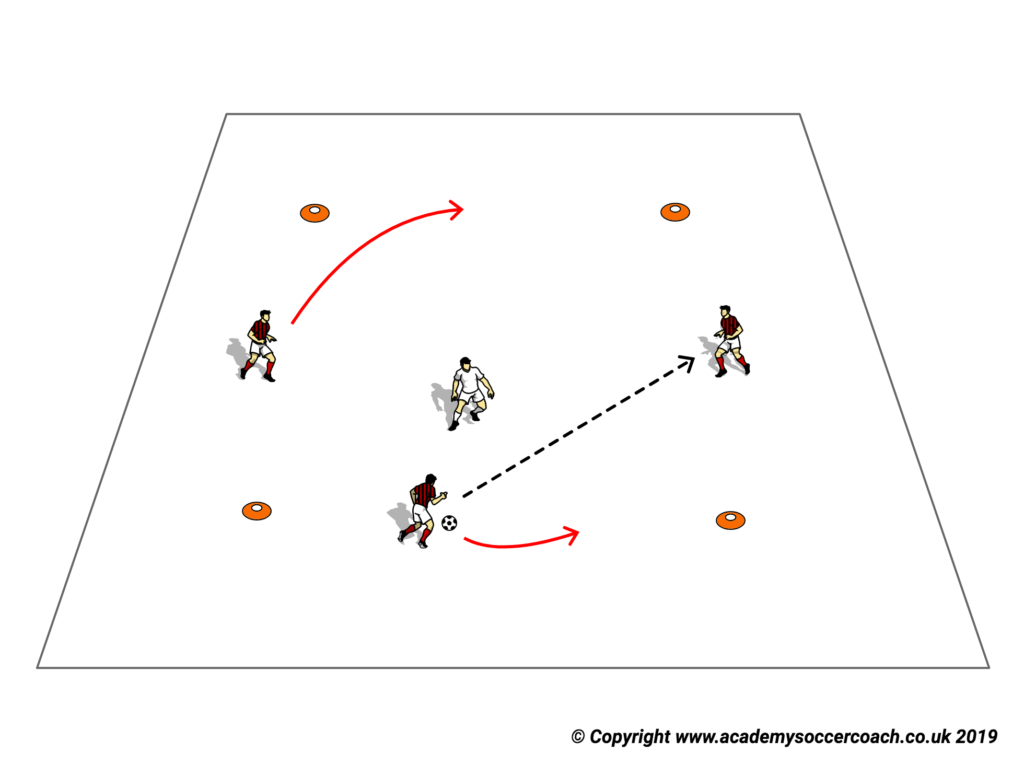It is common for younger players (and even older players) to be “goal-focused” – that is, playing only forward and within the channel where the ball is located. The problem is that opponents will quickly recognize this behavior and put players in front of the ball carrier – outnumbering us and, upon winning the ball, starting an immediate counterattack.
Here is an example of this in the 7v7 format:
It is fair to note that, for some opponents, there isn’t a conscious defensive strategy – their players are simply chasing the ball.
An important note here is the behavior of our supporting players – specifically in this video the 2 (right back) and 6 (center back). In the video example above, after the pass has gone from the 2 to the 8, both the 2 and the 6 are chasing the ball. The result is that we have eliminated the space in which the ball might be passed around the opponents. Instead, it will now be a fight to see whether we can keep the ball and get through the defensive block or whether the defenders will win the ball and get through our block.
Our response in this situation should be to coach our 8 to get their head up early AND for our 2 and 6 to create the spaces that can be used by 8 to pass back and recycle the ball through our backline. The video below is an “ideal” outcome where our team is able to draw the opponents to our right wing, switch through the back to the left side, then play an entry ball into our forward who finishes on the frame:
The full-sided game needs to be coached as a series of smaller-sided games that we can create in our training sessions. The work of the 2, 6, and 8 in this example should mimic how we work in our rondos:

An activity that I have recently programmed to develop this awareness in the larger game involves the use of channels (corridors) laid out on the field. The rule is that the player on the ball can dribble anywhere but any pass must be from one corridor to a different corridor – the ball cannot be played straight ahead or straight back. If the ball is passed in the same channel to a teammate, the game is stopped and the opponents restart with the ball:

There should be a couple of player behaviors that result from this rule:
- The player on the ball should be more connected to the environment – looking around to see the position of the opponents and teammates.
- The attacking players off the ball should be making movements to channels other than the “ball channel” in order to receive the ball.
Both of these behaviors are desirable in the real game.
A problem in working with players in this activity initially is that there are a lot of stops and starts as the players sort out the rule and what they need to do in the game. It is important to have patience and let the players sort this out without continually coaching them.
Within the overall context of our principles of play, this scenario and set of activities emphasize Manage Oneself (perceive/conceive, decide/deceive, execute/assess) and Manage The Ball (keep it simple, play what you see, receive with intent, pass with purpose, keep and move the ball, advance the ball).
As coaches, it is important that we link our principles of play to our small-sided and full game activities and that we are able to relate our rondos and small-sided games to the larger activities. It is natural that when we put a goal in front of the players, they will want to get to the goal and score – possibly abandoning the ideas that we’ve developed in our smaller activities. We need to continue to remind our players how we connect our training activities into the goal-based games.